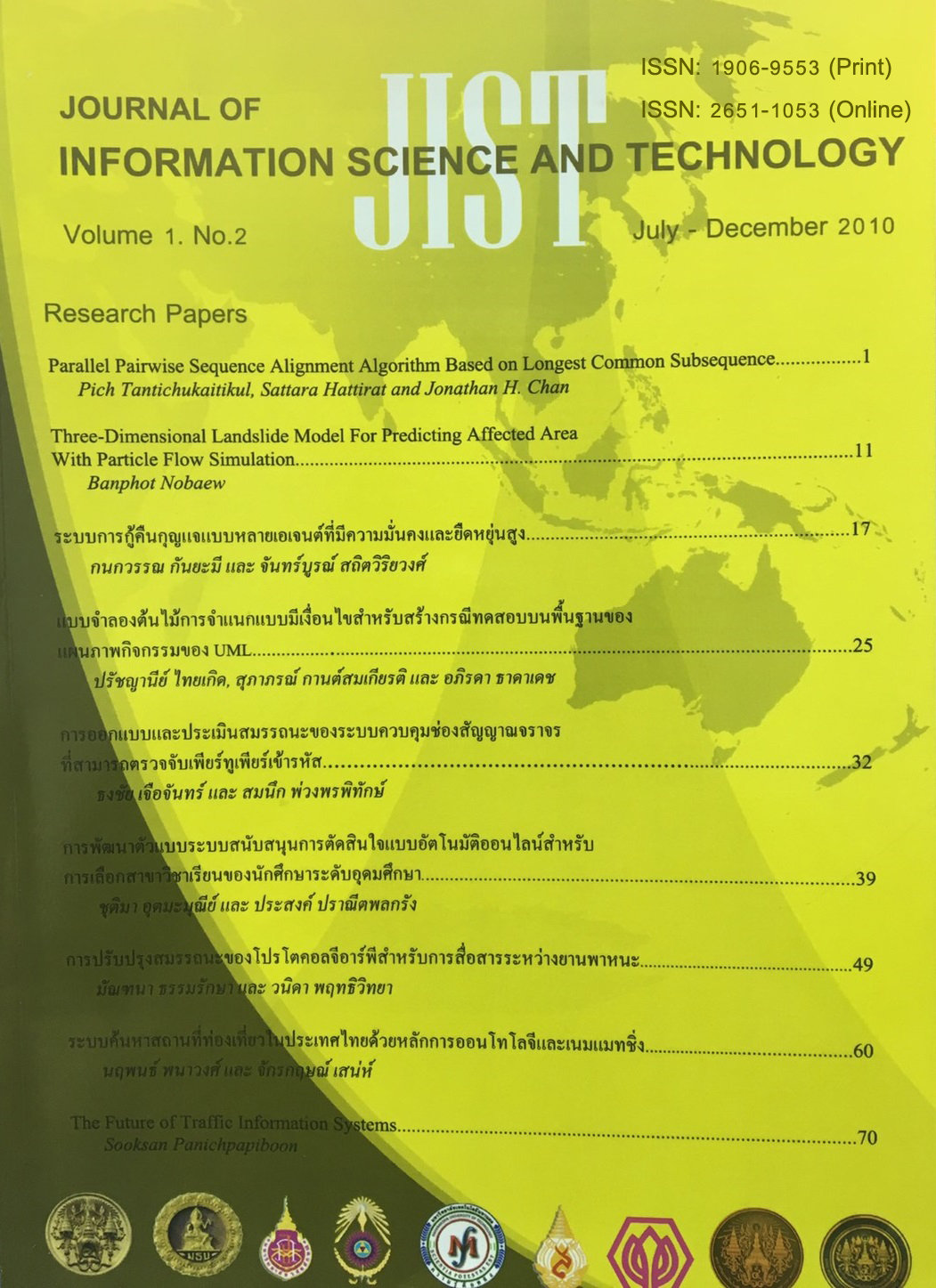ระบบการกู้คืนกุญแจแบบหลายเอเจนต์ที่มีความมั่นคงและยืดหยุ่นสูง
Main Article Content
บทคัดย่อ
- วิทยาการเข้ารหัสลับช่วยเพิ่มความมั่นคงปลอดภัยและความเป็นส่วนตัวให้กับผู้ใช้งานระบบเครือข่าย วิทยาการเข้ารหัสลับแบบสมมาตรใช้กุญแจลับเดียวกันทั้งการเข้ารหัสลับและการถอดรหัสลับข้อมูล ในกรณีที่ผู้รับไม่สามารถใช้กุญแจในการถอดรหัสลับข้อมูลได้หรือภาครัฐต้องการใช้สิทธ์ิในการเข้าถึงข้อมูล จะต้องขอใช้บริการกู้คืนกุญแจดังนั้นงานวิจัยนี้จึงได้เสนอระบบการกู้คืนกุญแจแบบหลายเอเจนต์ที่มีความมั่นคงและยืดหยุ่นสูง เรียกว่า เอสเอฟเอ็ม-เคอาร์เอส โดยเน้นกระบวนการทำงานที่มีความมั่นคงและความยืดหยุ่นสูงในการบริหารจัดการจำนวนเอเจนต์ที่ใช้ในการกู้คืนกุญแจ ให้สอดคล้องกับโยบายและสภาพแวดล้อมของการใช้งาน และได้ออกแบบกระบวนการกู้คืนกุญแจอย่างเหมาะสมโดยใช้แนวคิดการแบ่งแยกความลับ สามารถรองรับเหตุการณ์ที่มีบางเอเจนต์ล่ม เพื่อป้องกันปัญหาการล้มเหลวเพราะจุดเดียว อีกทั้งระบบยังสนับสนุนการตรวจสอบข้อมูลโดยชอบด้วยกฎหมายและทำงานบนโครงสร้างพื้นฐานกุญแจสาธารณะ
Article Details
This work is licensed under a Creative Commons Attribution-NonCommercial-NoDerivatives 4.0 International License.
I/we certify that I/we have participated sufficiently in the intellectual content, conception and design of this work or the analysis and interpretation of the data (when applicable), as well as the writing of the manuscript, to take public responsibility for it and have agreed to have my/our name listed as a contributor. I/we believe the manuscript represents valid work. Neither this manuscript nor one with substantially similar content under my/our authorship has been published or is being considered for publication elsewhere, except as described in the covering letter. I/we certify that all the data collected during the study is presented in this manuscript and no data from the study has been or will be published separately. I/we attest that, if requested by the editors, I/we will provide the data/information or will cooperate fully in obtaining and providing the data/information on which the manuscript is based, for examination by the editors or their assignees. Financial interests, direct or indirect, that exist or may be perceived to exist for individual contributors in connection with the content of this paper have been disclosed in the cover letter. Sources of outside support of the project are named in the cover letter.
I/We hereby transfer(s), assign(s), or otherwise convey(s) all copyright ownership, including any and all rights incidental thereto, exclusively to the Journal, in the event that such work is published by the Journal. The Journal shall own the work, including 1) copyright; 2) the right to grant permission to republish the article in whole or in part, with or without fee; 3) the right to produce preprints or reprints and translate into languages other than English for sale or free distribution; and 4) the right to republish the work in a collection of articles in any other mechanical or electronic format.
We give the rights to the corresponding author to make necessary changes as per the request of the journal, do the rest of the correspondence on our behalf and he/she will act as the guarantor for the manuscript on our behalf.
All persons who have made substantial contributions to the work reported in the manuscript, but who are not contributors, are named in the Acknowledgment and have given me/us their written permission to be named. If I/we do not include an Acknowledgment that means I/we have not received substantial contributions from non-contributors and no contributor has been omitted.
เอกสารอ้างอิง
2. S.T. Walker, S.B. Lipner, C.M. Ellison and D.M. Balenson, “Commercial Key Recovery”, Communications of the ACM, Vo1. 39, No. 3, pp. 41-47, March 1996.
3. Y.Y. Al-Salqan, “Cryptographic Key Recovery”, the 6th IEEE Computer Society Workshop on Future Trends of Distributed Computing Systems. October 1997, pp. 34-37.
4. B.W. McConnell, E.J: Appel, Enabling Privacy, Commerce, Security and Public Safety in the Global Information Infrastructure. http://epic.org/crypto/key_escrow/white_paper.html (1996). Accessed 30 September 2009.
5. Yung-Cheng Lee and Chi-Sung Laih, “On the Key Recovery of the Key Escrow System”, the 13th Annual Computer Security Applications Conference. December 1997, pp. 216-220.
6. S. Lim, S. Kang, and J. Sohn, “Modeling of Multiple Agent Based Cryptographic Key Recovery Protocol”, the 19th Annual Computer Security Applications Conference, Las Vegas, December 2003, pp. 119-128.
7. Shin-Young Lim, Ho-Sang Hani, Myoung-Jun Kim and Tai-Yun Kim, “Design of Key Recovery System Using Multiple Agent Technology for Electronic Commerce”, Proc. International Symposium On Industrial Electronics 2001, pp. 1351-1356.
8. D.E. Denning and D.K. Branstad, A Taxonomy for Key Recovery Encryption Systems. Internet Besieged: Countering Cyberspace Scofflaws, 1998.
9. K. Kanyamee and C. Sathitwiriyawong, “A Simple High- Availability Multiple-Agent Key Recovery System”, the 4th International Conference for Internet Technology and Secured Transactions. London, 2010, pp. 734-739.
10. R. Perlman, “An Overview of PKI Trust Models,” IEEE Network. Vol. 13, Issue 6, pp. 38-43, November 1999.
11. Paolo D'Arco, “On the Distribution of a Key Distribution Center”, the 7th Italian Conference on Theoretical Computer Science. 2001, pp. 357-369.
12. Neuman, B.C. and Ts'o, T, “Kerberos: an Authentication Service for Computer Networks”, Communications Magazine of the IEEE, Vol. 32, pp. 32-38, September 1994.
13. Bruce Schneier, Applied Cryptography, New York. NY, John Wiley & Sons, 1996.



